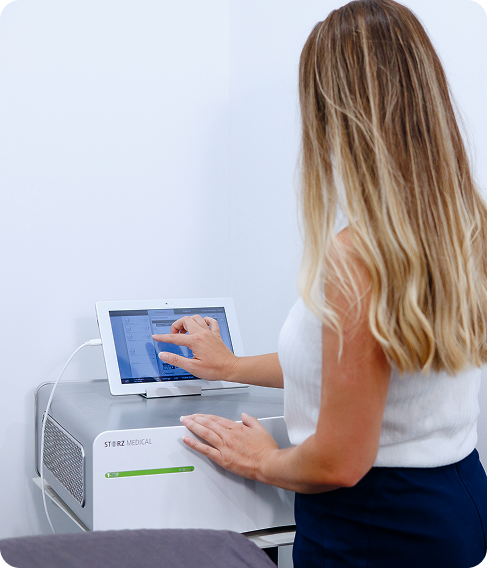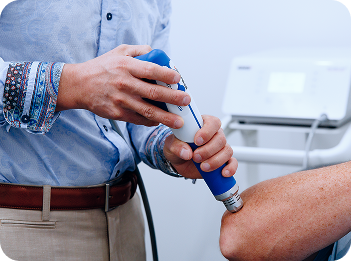Advanced Magnetolith (EMTT) for Back Pain and Musculoskeletal Disorders


How Electromagnetic Transduction Therapy Supports Cellular Healing and Regeneration

Recurrent pain, joint stiffness, or delayed soft tissue healing can persist even after rest or rehabilitation. When inflammation or cellular disruption affects deeper structures, it can be difficult to target these areas using traditional therapies.
Conditions Often Managed With the Help of EMTT Sessions
Electromagnetic transduction therapy may be used as part of a non-invasive approach to managing musculoskeletal discomfort. EMTT sessions assist by applying magnetic pulses to areas of discomfort or restricted movement.
Lower back pain
Lower back pain may involve strain or inflammation in deeper spinal tissues. EMTT sessions help by applying magnetic pulses to tissues that are harder to access with traditional approaches.
Shoulder tendinopathy
This condition often affects the rotator cuff and may result from repetitive overhead movement. EMTT may be used to address shoulder mobility limitations to ease tension and promote more comfortable arm movement.
Osteoarthritis (knee or hip)
Osteoarthritis can cause joint stiffness, swelling, and discomfort due to cartilage breakdown. EMTT may target the affected area to help improve range of motion, promote comfort during standing and walking, and lessen inflammation.
Plantar fasciitis
Heel pain from plantar fasciitis may involve irritation in the tissue along the sole. EMTT may be used on the heel region to help reduce tissue irritation and achieve comfort during daily movement.
Achilles tendinopathy
This condition involves thickening and irritation of the Achilles tendon. EMTT may be applied to the lower leg and heel area to help ease tendon stiffness, reduce irritation, and support ankle mobility.
Tennis elbow
Tennis elbow often results from repetitive strain in the forearm. EMTT may be used over the outer elbow region to help manage tenderness, reduce muscle tension, and promote comfortable arm movement.
Frozen shoulder
Also known as adhesive capsulitis, frozen shoulder limits movement due to stiffness in the joint capsule. EMTT may be applied to the shoulder to help ease stiffness, support mobility, and reduce discomfort during movement.
Hip bursitis
Hip bursitis involves inflammation of the fluid-filled sacs near the joint. EMTT may be directed to the hip region to help reduce swelling and improve comfort when sitting, standing, or walking.
Patellar tendonitis
Often referred to as jumper’s knee, this condition affects the tendon between the kneecap and shin. EMTT may target the knee to help relieve tenderness, reduce strain during bending, and support comfort during daily activities.
What Happens During Your Initial EMTT Magnetolith Therapy Visit
Your first EMTT Magnetolith Therapy in Perth appointment focuses on understanding your symptoms and reviewing your health history. This information can help us provide effective musculoskeletal pain management.
Brief History and Discussion
You’ll be asked about your condition, current symptoms, and previous therapies. This helps determine whether EMTT may complement your treatment plan for chronic pain therapy in Perth.
Physical Examination
Your medical practitioner will gently assess the affected area. This step helps us identify areas of discomfort or limited function, allowing us to design your electromagnetic transduction therapy plan accurately.
Explanation of the EMTT Process
You’ll be guided through how the therapy works and what to expect during treatment. The practitioner will explain how EMTT may fit into your care plan for chronic pain therapy in Perth.
Initial EMTT session
If appropriate, a short session is conducted. Pulsed magnetic fields are applied to the surface near the affected area to begin your electromagnetic transduction therapy.
You’ll be asked about your condition, current symptoms, and previous therapies. This helps determine whether EMTT may complement your treatment plan for chronic pain therapy in Perth.
Your medical practitioner will gently assess the affected area. This step helps us identify areas of discomfort or limited function, allowing us to design your electromagnetic transduction therapy plan accurately.
You’ll be guided through how the therapy works and what to expect during treatment. The practitioner will explain how EMTT may fit into your care plan for chronic pain therapy in Perth.
If appropriate, a short session is conducted. Pulsed magnetic fields are applied to the surface near the affected area to begin your electromagnetic transduction therapy.
Positive Effects of EMTT Magnetolith Therapy Backed by Clinical Use
EMTT is used as a form of non-invasive pain therapy in Perth. It may complement musculoskeletal care plans when other treatments haven’t fully addressed symptoms like discomfort or mobility restrictions.

Potential Benefits
- EMTT may help ease discomfort and stiffness in hard-to-reach areas, including the shoulder capsule and lower back, and support comfortable movement.
- When included in a clinician-guided care plan, it may support better mobility and daily function for people managing chronic soft tissue concerns through everyday tasks and exercise.
- EMTT may complement physiotherapy or other supportive strategies, providing an additional option that could assist with tendon or joint-related discomfort and overall comfort.
Potential Limitations
- EMTT is not a substitute for diagnosis or medical intervention. It is generally considered a part of a broader approach to musculoskeletal care, and outcomes may vary between individuals.
- This non-invasive pain therapy in Perth may not be suitable for everyone; suitability depends on individual health history, which will be discussed before starting treatment.
- Evidence is still developing for some musculoskeletal presentations, and individual responses to EMTT may vary.
Who May Benefit Most from EMTT Magnetolith Care
EMTT may be included in a comprehensive care plan for individuals experiencing continuous musculoskeletal discomfort. This may be especially relevant when symptoms affect deeper tissues or persist despite other conservative treatments.

Persistent Musculoskeletal Discomfort

Hard-to-access symptom areas

Looking for non-invasive options
Why Choose Us for EMTT Magnetolith Therapy
Experience care that blends advanced technology, personalised treatment, and compassionate support—helping you feel confident, understood, and empowered throughout your therapy journey.
Advanced Technology for Targeted Care
Our EMTT Magnetolith Therapy uses advanced electromagnetic technology to help stimulate your body’s natural recovery. Each session is delivered with precision, offering comfort while addressing your specific needs. We combine innovation with compassion, so you feel supported and confident throughout your treatment journey.
Personalised Treatment Plans for You
Every person’s path to improved comfort and mobility is unique. We create personalised EMTT plans that reflect your lifestyle, goals, and condition. By listening closely and adapting care, we help you feel valued, understood, and confident as you take meaningful steps toward a healthier, more active future.
Supportive Team Throughout Your Journey
From the moment you walk through our doors, you are welcomed by a caring team that truly listens. We guide, encourage, and support at every stage, creating an environment where you feel safe, understood, and motivated to achieve your therapy goals with trust, comfort, and confidence.
Commitment to Long-Term Wellbeing
We focus on more than easing discomfort—we’re committed to helping you maintain healthy mobility for the long term. By supporting your body’s natural healing process, we aim to help you move with confidence, live without limitations, and embrace each day with energy, comfort, and a renewed sense of possibility.
Schedule an EMTT Session to Help Promote Physical Recovery
Ready to explore whether EMTT sessions could help with your goals? Schedule a consultation to discuss your needs and see if this non-invasive therapy may be suitable for your situation.
Get to Know Nicholas Wigger
Nicholas Wigger is a highly regarded physiotherapist in Perth with nearly two decades of clinical experience. He takes a modern, results-focused approach to musculoskeletal care, helping patients recover mobility and function using advanced technologies and hands-on techniques.

Nick Wigger
Advanced Level 3 GEMt Dry Needler
- MD, PhD
- 15+ Years
"I'm committed to using evidence-based techniques that show effective results without overcomplicating what good care should be."
Nick is widely recognised for his work in musculoskeletal therapy. He combines manual therapy with non-invasive modalities such as shockwave, magnetotransduction, and photobiomodulation. These tailored techniques help support faster recovery, improve mobility, and promote long-term comfort for patients.
Cost and Payment Options
EMTT session costs may vary depending on your treatment plan. During your consultation, your practitioner will explain expected fees and available payment arrangements tailored to your situation.
Initial Consultation
$220.00
AUD
- This 30-minute appointment includes a detailed review of your health history and symptoms.
- You will have time to discuss your goals and concerns in detail.
- Your practitioner will outline and explain a personalised care plan to help you make treatment decisions.
Standard Consultation
$220.00
AUD
- This 15-minute session focuses on reviewing your progress since your last visit.
- Your health practitioner will make any needed adjustments to your therapy approach.
- This is your time to discuss and address any new or ongoing concerns.
Extended Consultation
$270.00
AUD
- This 30-minute extended appointment allows more time for complex or multiple concerns.
- Your health practitioner will conduct a detailed discussion about your symptoms.
- During this extended consultation, extra time is allotted for any necessary therapy.
Frequently Asked Questions About EMTT Magnetolith Therapy
Understanding the advantages of shockwave therapy can help you decide about this treatment option. Here are some common questions about shockwave therapy and insightful answers to clarify its key benefits and applications.
Is EMTT safe to use?
EMTT Magnetolith Therapy is generally considered safe when delivered by a trained health professional in an appropriate setting. It uses high-energy magnetic pulses targeted at specific areas to help manage certain musculoskeletal conditions, such as patellar tendonitis, frozen shoulder, and lower back pain.
Before starting, your healthcare provider will review your health history, including pre-existing conditions and medications, to confirm suitability. This assessment helps identify any factors, such as implanted devices or medical conditions, that could affect treatment safety.
Will I feel anything during the session?
During your EMTT Magnetolith Therapy in Perth, you may notice certain sensations in the area where therapy is administered. These sensations are a normal part of the process and can vary between individuals.
Here are common experiences and their explanations:
- Gentle rhythmic tapping: You may feel a pulsing or tapping sensation as the magnetic field interacts with tissues. The sensation is caused by rapid changes in the electromagnetic field, which stimulate nerve and muscle fibres.
- Mild tingling: A light tingling can occur during the session as nerve endings respond to the electromagnetic pulses. This feeling is generally short-lived.
- Warmth in the involved area: You may notice a slight increase in warmth where the applicator is placed. This effect is due to increased blood flow, which is a natural response to therapy.
- Minor muscle twitching: The magnetic pulses may cause small, involuntary muscle contractions. This sensation is a normal response and discontinues once the device is turned off.
Sensations can differ depending on the treatment site, individual sensitivity, and therapy settings. Your healthcare provider can adjust the device to maintain comfort.
How many sessions do people usually book?
The number of EMTT Magnetolith Therapy sessions can vary based on the condition being managed and individual goals. Your healthcare provider will create a plan tailored to your needs after assessing your health history and circumstances.
Below are some factors that can influence how many sessions are recommended:
- Nature of the condition: Acute conditions may require fewer sessions than long-term or recurring issues. For example, a recent sports strain may need a short treatment course, while persistent back discomfort could require more sessions over time. Your provider will consider whether the concern is recent or has been present for some time.
- Treatment goals: Goals can range from easing discomfort to supporting mobility and function. The intended outcome can influence the frequency and total number of sessions.
- Individual response: People respond differently to EMTT. For example, someone with mild joint stiffness might notice changes after around three to six appointments, while a person with persistent tendon discomfort may need more sessions for noticeable effects. Your provider will review progress and adjust the plan as needed.
- Integration with other therapies: EMTT may be combined with physiotherapy, exercise programs, or other modalities, which can affect how many sessions are booked. For example, someone receiving EMTT alongside an exercise plan as part of chronic pain therapy in Perth may attend appointments less frequently. This frequency is compared to when EMTT is used alone.
The suggested schedule will align with safety guidelines and your provider’s clinical judgement. Your provider will review your progress at agreed intervals and may adjust the number of sessions accordingly.
Can I go back to work after my appointment?
Some people may return to their usual activities, including work, soon after their EMTT appointment. This can depend on your response and the nature of your work.
Here are some factors that may influence your return:
- Type of work: If your job involves mainly desk-based or light duties, you may be able to resume work immediately after the appointment.
- Physical demands: For roles involving heavy lifting, repetitive movements, or high-impact activities, your provider may suggest a short rest period. This rest period is usually around 30 minutes to one hour before resuming work.
- Treatment area: The part of the body receiving therapy can affect how you feel afterwards. For example, sessions involving lower limbs may feel different from those focusing on the shoulder or back. This difference is due to variations in muscle size, nerve sensitivity, and how each area responds to electromagnetic stimulation.
- Your response to therapy: Some people may experience mild, temporary effects like muscle twitching or tingling, which usually settle within 5 to 10 minutes. If these occur, a short break of about 10 to 15 minutes before work may be helpful.
Does EMTT use any needles or injections?
EMTT is a non-invasive treatment that does not involve needles or injections. It uses a Magnetolith device, which delivers electromagnetic fields externally through an applicator placed on or near the skin.
Will I need to change clothes for EMTT?
In most cases, you will not need to change clothes, as the electromagnetic pulses can pass through light, comfortable clothing. Your healthcare provider may ask you to remove metal accessories or objects, such as belts or jewellery, from the therapy area. This helps prevent interference with the electromagnetic field during the session.
Can I drive after having EMTT therapy?
Most people can drive after EMTT Magnetolith Therapy, as it does not typically cause drowsiness or impaired coordination. If you feel unusual discomfort or temporary sensations, such as tingling or muscle twitching, waiting around 5 to 10 minutes before driving may be sensible. Your healthcare provider can offer advice based on how you respond during your session.
Do I need to bring anything to the appointment?
You do not usually need to bring special items for an EMTT appointment, but the following can help your session run smoothly:
- Referral or medical records: If your healthcare provider has asked for these, bring any recent scans, reports, or referral letters.
- List of medications: Include prescription, over-the-counter, and supplement details so your provider can review them.
- Comfortable clothing: Light, non-restrictive clothing allows easy access to the area where therapy will be administered.
- Payment method: Bring your preferred payment method if payment is due on the day of your appointment.
Can I still take my usual medications with EMTT?
In many cases, people can continue their usual medications during EMTT Magnetolith Therapy, but this should be confirmed with your healthcare provider. Always inform them about all medicines and supplements you take so they can check for any possible interactions. This includes prescription medications, over-the-counter products, and herbal or nutritional supplements. Your provider will review this information before starting therapy to confirm it is appropriate for your situation.
Is this something I can do if I’m pregnant?
EMTT Magnetolith Therapy is generally not recommended during pregnancy. Because safety data on strong electromagnetic fields in pregnancy are limited, a precautionary approach is recommended. If you are pregnant or think you may be pregnant, tell your healthcare provider before starting therapy. They can discuss alternatives or advise postponing treatment based on your circumstances.
Will I get results after just one session?
Responses to EMTT can differ between individuals. The timeframe often depends on factors such as the nature of the condition, how long it has been present, and your overall health status. Some people may notice changes within three to six appointments, while others may experience gradual improvements over several weeks. In many cases, noticeable benefits may require continuous sessions. Your healthcare provider will review your progress regularly and adjust your plan if needed to help you achieve your goals safely.
Does EMTT affect pacemakers or other devices?
Yes, EMTT Magnetolith Therapy is not recommended for people with pacemakers or certain implanted medical devices. The strong electromagnetic fields used during therapy can interfere with the function of pacemakers, defibrillators, neurostimulators, or other implanted electronic or metallic devices. If you have one of these, inform your healthcare provider before starting therapy. They can determine whether EMTT is appropriate or suggest an alternative approach.
Find More Contact Information Here
Contact us today to discover more about our services and how we can assist you. Our friendly staff is available to answer any questions and schedule your appointments.
Location
Surgeons House, 162 Cambridge Street, West Leederville WA
Email Us
Call Us
Working Hours
Tuesday to Friday: 9:00 AM - 5:00 PM
Saturday to Monday: CLOSED
